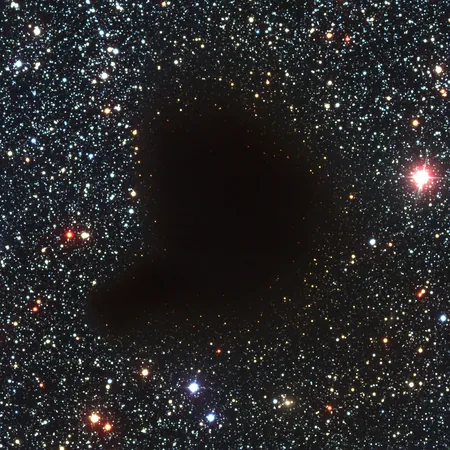
Unlocking the Secrets of the Interstellar Medium: The Molecules that Shape Our Universe
2025-07-11
Author: Siti
In the vast emptiness of space, stars don't simply appear out of nowhere. Unraveling the mystery of how gas and dust coalesce into stars is no small feat, particularly since these materials meander through the galaxy at near absolute zero temperatures, emitting almost no light! However, this very obscurity holds the key to understanding them: they create "absorption lines" that reveal the composition of the substances the light traverses on its journey to Earth.
A groundbreaking new study by Harvey Liszt from the National Radio Astronomy Observatory and Maryvonne Gerin of the Sorbonne has unveiled how astronomers can utilize these absorption lines through radio astronomy to chart the elusive 'dark neutral medium' of interstellar gas scattered throughout the galaxy.
The Experiment: A Journey Through Light
The research examined 88 'sight lines'—imaginary lines drawn from Earth to bright celestial objects like quasars. As light from these vibrant entities makes its way toward us, it is partially absorbed by the interstellar medium (ISM), resulting in a distinctive darkening in the spectrum of light.
Using data from illustrious radio telescopes such as the Atacama Large Millimeter/Submillimeter Array (ALMA), the Institut de radioastronomie millimétrique at the Sorbonne, and the Arizona Radio Observatory—some of which date back a staggering 30 years—the paper delves into the intricate dance of molecular interactions in the ISM.
Key Molecules: Hints from the Dark
Focusing on six different ions, the research yielded varied results. The formyl cation (HCO+) emerged as the star of the show, detected in 72 out of 86 studied sight lines. This molecule serves as a crucial predictor of hydrogen gas (H2), the universe's most abundant molecule, which remains notoriously difficult to identify directly. When cosmic rays bombard H2 and other elements, HCO+ forms, indicating that where HCO+ flourishes, H2 likely follows.
Another significant player, hydrogen cyanide (HCN), was previously thought to be confined to regions dense with star formation. This study challenges that notion, illuminating its presence across the ISM and necessitating a reassessment of its formation processes.
The ethynyl radical (C2H) also played a pivotal role, revealing how basic hydrocarbons might evolve into complex molecules as they react within the ISM. Notably, the ratio of C2H to HCO+ shifts depending on local conditions like dust content, offering a treasure trove of information about the interactions taking place in specific regions of space.
Challenges in Tracking Molecular Companions
However, not all molecules were easily accounted for. The study failed to detect carbon monosulfide (CS), and carbon monoxide (CO) only appeared in conjunction with HCO+, limiting its functional value even though it shone about 100 times brighter. Regular formyl radicals (HCO), while prevalent, posed difficulties in detection, making them less practical for estimating the presence of these elusive gas clouds.
A Bright Future for Astronomical Exploration
This meticulous tracking of gases throughout the galaxy is more than just a scientific exercise—it's a potential roadmap guiding us to new star-forming regions. As advanced telescopes come online, enhancing the clarity of signals from these molecules, we stand at the brink of unveiling the 'dark' realms of our universe, which are alive with the cosmic materials ready to ignite the next generation of stars.


 Brasil (PT)
Brasil (PT)
 Canada (EN)
Canada (EN)
 Chile (ES)
Chile (ES)
 Česko (CS)
Česko (CS)
 대한민국 (KO)
대한민국 (KO)
 España (ES)
España (ES)
 France (FR)
France (FR)
 Hong Kong (EN)
Hong Kong (EN)
 Italia (IT)
Italia (IT)
 日本 (JA)
日本 (JA)
 Magyarország (HU)
Magyarország (HU)
 Norge (NO)
Norge (NO)
 Polska (PL)
Polska (PL)
 Schweiz (DE)
Schweiz (DE)
 Singapore (EN)
Singapore (EN)
 Sverige (SV)
Sverige (SV)
 Suomi (FI)
Suomi (FI)
 Türkiye (TR)
Türkiye (TR)
 الإمارات العربية المتحدة (AR)
الإمارات العربية المتحدة (AR)